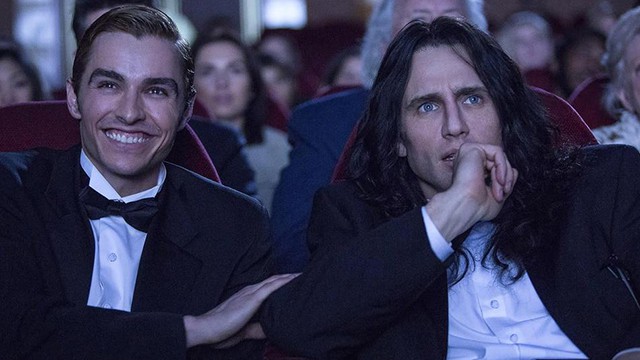inHalton Does TIFF: The Disaster Artist Hits a High Note
Published September 13, 2017 at 9:16 pm

If you haven’t heard of The Room–known for being, quite possibly, the best bad movie of all time–you’re not alone.
But you are missing out.
If you haven’t heard of The Room–known for being, quite possibly, the best bad movie of all time–you’re not alone.
But you are missing out.
And if you were at the Toronto International Film Festival (TIFF) recently, James Franco’s take on the engrossing story behind one of cinema’s greatest misfires was definitely the film to see.
Every once in awhile, a movie that’s gloriously, outrageously bad becomes a monumental cult hit, attracting small but devoted crowds to midnight screenings and independently-run bad movie nights hosted in community spaces and living rooms. The Room, a bizarre 2003 “drama” written, directed, produced and funded (reportedly to the tune of $6 million) by lead actor Tommy Wiseau, is one such film.
The film, a badly written and poorly acted melodrama about an all-American good guy (with a mysterious Eastern European-ish accent) who is betrayed by his fiancee and best friend, became something of a hit when it premiered to uproarious laughter and genuine affection in Los Angeles in the early aughts. The film truly has it all–a ridiculous script, an absurdly overwrought plot, lacklustre performances and revolting sex scenes–and it’s amassed quite the following.
The story behind the troubled production and the bizarre and mysterious director and star eventually became the subject of The Disaster Artist: My Life Inside The Room, the Greatest Bad Movie Ever Made, a memoir penned by Wiseau’s friend and co-star Greg Sestero (who wrote the book in conjunction with writer Tom Bissell).
The Disaster Artist film, which just premiered to much fanfare at TIFF, is based on that book.
And while you don’t have to see The Room or read The Disaster Artist to appreciate the film, doing both will only enhance your enjoyment.
The film, directed by James Franco and populated by a star-studded cast that includes Franco himself, Dave Franco (James’ younger brother), Seth Rogen, Alison Brie, Josh Hutcherson and Zac Efron (to name a few), is an exceptionally engrossing–and fair and kind–look at a stunningly poor but fascinating production helmed by a strange and often clueless man who obsessively hides any and all details of his personal life.
The elder Franco plays the mysterious Wiseau with incredible aplomb. In fact, his transformation is staggering. Donning a long black wig and expertly mimicking Wiseau’s difficult accent and signature “ha ha ha” laugh, it was hard to believe that Franco was not actually Wiseau.
The resemblance is truly uncanny.
The film explores the real-life relationship between Wiseau and Sestero, Wiseau’s Room co-star and the author of the memoir on which the film is based.
The film kicks off in the late 90s when the two strike up an unlikely friendship after Sestero applauds Wiseau for his no-holds-barred performances in acting classes. After bonding over their shared ambitions, the two decide to move to L.A. together to pursue Hollywood careers.
From the beginning, Wiseau is cagey about his past. He insists he’s from New Orleans, even though his accent is decidedly foreign. He also insists he’s the same age as the 20-something Sestero, even though he doesn’t look a day under 40. Wiseau also refuses to disclose the source of his seemingly endless wealth (he maintains at least two residences in California, purchases prohibitively expensive equipment to make The Room and funds the entire multi-million dollar production himself).
When the duo arrive in L.A., they fail to gain much traction. While Sestero doesn’t land any roles, he does land a girlfriend–something that amplifies Wiseau’s latent but apparent jealousy of Sestero’s youth and conventional good looks. While Sestero quietly accepts his lack of professional success, Wiseau becomes angry and aggressive in the face of rejection, lashing out at acting instructors and obnoxiously confronting a producer (played by Judd Apatow in a fun cameo) at a restaurant.
After failing to gain ground in an industry that wants nothing to do with them–especially the awkward and occasionally off-putting Wiseau–they decide to make their own movie.
And The Room is born.
The film, which highlights Wiseau’s weirdness while refraining from making him into a joke, doesn’t shy away from showcasing a troubled production staffed by stressed and bullied actors and crew who are lorded over by, for all intents and purposes, a misguided idiot savant with delusions of grandeur and no idea what he’s doing.
Wiseau has trouble remembering even simple lines and takes his frustrations out on his cast and crew, criticizing co-star Juliette Danielle (played by For a Good Time, Call’s Ari Graynor) for having mild blemishes on her shoulders during an already noxious love scene and demanding an elderly member of the cast keep working after she falls ill due to poor ventilation on set.
As the production goes on, we see Wiseau and Sestero’s friendship tested and Wiseau’s “vision” questioned by rightfully irate employees.
But while the film could have focused on its decidedly weird and seemingly delusional star and what a monster he became, it manages not to dwell on Wiseau’s eccentricities in a cruel or mocking way. Ultimately, it’s a movie about jealousy, insecurity and carving out a niche for oneself after all other avenues have been exhausted.
It’s a truly loving–and expertly crafted–tribute to a film that has brought so many people incredible joy.
If you didn’t catch it at TIFF, be sure to see it when it hits theatres in December.
In the meantime, do yourself a favour and grab The Room on Amazon. You won’t regret it.
insauga's Editorial Standards and Policies advertising





